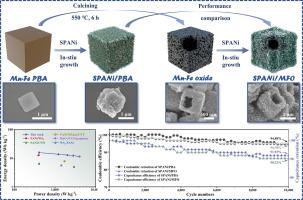Sulfonated polyaniline coated Prussian blue analog derived Mn-Fe oxide composite electrode for all-solid-state flexible supercapacitors
IF 13.3
1区 工程技术
Q1 ENGINEERING, CHEMICAL
引用次数: 0
Abstract
Polyaniline (PANi) is extensively utilized for supercapacitors because of its peculiar doping mechanism and excellent redox properties. However, since its one-dimensional molecular chains usually exist in an aggregated and disordered structure, the PANi backbone is subject to deformation and degradation during charging and discharging processes, which leads to its low actual specific capacitance and rapid structural collapse. To address these challenges, we propose the synthesis of a sulfonated polyaniline (SPANi) structure by one-step copolymerization, which immobilizes the sulfonic acid group (−SO3H) onto the PANi backbone. The presence of −SO3H helps to promote the redox reaction of PANi to proceed and augment the pseudocapacitive properties. Subsequently, SPANi is further polymerized in-situ on Mn-Fe oxide (MFO) derived from Prussian blue analog to prepare a novel conductive polymer-encapsulated bimetallic oxide hollow nanocube composite material, designated as SPANi/MFO. It demonstrates a remarkable specific capacitance of 597.06 F g−1 at 1 A g−1 owing to its superior structural, and maintains 89.05 % of its initial capacity after 10,000 cycles. Assembly of supercapacitors with PAAM/H2SO4 gel electrolyte demonstrates a notable specific capacitance of 177.43 F g−1 and cycling performance of 90.32 % after 10,000 cycles, the device also exhibits an energy density of 15.77 Wh kg−1 (400 W kg−1). This paper provides a useful method to prepare modified PANi coated functional nanomaterial composite electrodes for supercapacitors.

求助全文
约1分钟内获得全文
求助全文
来源期刊

Chemical Engineering Journal
工程技术-工程:化工
CiteScore
21.70
自引率
9.30%
发文量
6781
审稿时长
2.4 months
期刊介绍:
The Chemical Engineering Journal is an international research journal that invites contributions of original and novel fundamental research. It aims to provide an international platform for presenting original fundamental research, interpretative reviews, and discussions on new developments in chemical engineering. The journal welcomes papers that describe novel theory and its practical application, as well as those that demonstrate the transfer of techniques from other disciplines. It also welcomes reports on carefully conducted experimental work that is soundly interpreted. The main focus of the journal is on original and rigorous research results that have broad significance. The Catalysis section within the Chemical Engineering Journal focuses specifically on Experimental and Theoretical studies in the fields of heterogeneous catalysis, molecular catalysis, and biocatalysis. These studies have industrial impact on various sectors such as chemicals, energy, materials, foods, healthcare, and environmental protection.
 求助内容:
求助内容: 应助结果提醒方式:
应助结果提醒方式:


